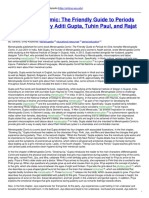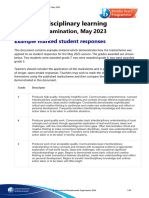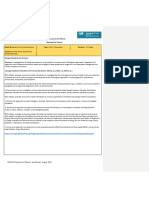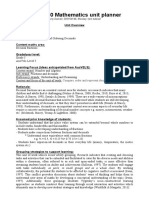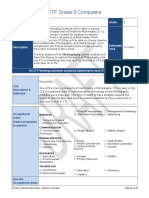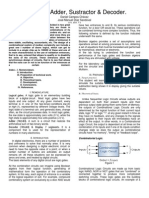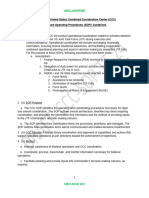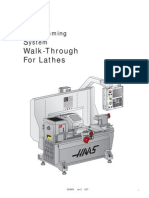6) V40N4 - Technology - Boon or Bane PDF
6) V40N4 - Technology - Boon or Bane PDF
Uploaded by
Vidur JoshiCopyright:
Available Formats
6) V40N4 - Technology - Boon or Bane PDF
6) V40N4 - Technology - Boon or Bane PDF
Uploaded by
Vidur JoshiOriginal Title
Copyright
Available Formats
Share this document
Did you find this document useful?
Is this content inappropriate?
Copyright:
Available Formats
6) V40N4 - Technology - Boon or Bane PDF
6) V40N4 - Technology - Boon or Bane PDF
Uploaded by
Vidur JoshiCopyright:
Available Formats
features 50
Technology—Boon or Bane?
by ME5 Seah Ser Thong, Calvin, ME4 Yap Chun Hong, Kelvin & Ms Malini Deepan
Abstract:
The utility of technology in the military context has grown at a ubiquitous rate, from raw firepower to warfare
support systems and logistic environments. Rapid development of technology has allowed the military to expand
the capabilities and aptitude of its forces by a pronounced extent in the past half a decade. As a result,
the military has become increasingly reliant on technology and there is a need for sufficient and effective
management structures to prevent an emergency in the event that technology fails us. Thus, we can see that
technology can be a double edged sword; it can be a formidable instrument or a life-saving mechanism in times
of crisis or a possible perilous shortcoming if mismanaged or not used to its fullest advantage.
Keywords: Management, Technology Roadmap, Technology Advancement, Technology Management
INTRODUCTION ADVANTAGES OF TECHNOLOGY
“God fights on the side with the best artillery.” Technology has often been the cornerstone of many
militaries and has been wielded by many countries to
Napoleon Bonaparte1
gain a decisive victory in conflicts. The advantages
Military technology has evolved continuously that technology can provide to the military include
the following:
through the ages to improve the mobility, firepower
and protection of troops. We have seen the evolution
Maintain Capability Superiority
from cavalry to unmanned vehicles, from gunpowder The main advantages would be for the country to
to guided weapons and from bronze shields to maintain its capability superiority over its potential
composite armour. Through the years, we have seen adversaries and to ensure its swift and decisive
militaries competing in the arms race and showcasing response to any potential threats. At the same
the latest technologies and latest weapons. Since the time, this may reduce combat losses of lives and
early 1900s, technology has dominated warfare and equipment. An example of this was in the Persian
may have contributed to 190 million fatalities during Gulf War, which was won by the Coalition forces in a
the 25 biggest conflicts of the 20 th century. However, short time—a ground attack which lasted 100 hours
is the constant introduction of technology only a in February 1991. This was due to the technological
surface solution or can it really elevate a military sophistication of United States (US) weapons and
logistic support systems.2
over its adversaries? This essay will explore the pros
and cons of the constant introduction of technology
Technological Surprise
and discuss how technology should be introduced and
All militaries need to create technological surprises
managed in the military context.
to its adversaries as well as to conversely prevent
POINTER, JOURNAL OF THE SINGAPORE ARMED FORCES VOL.40 NO.4
5 AmendedTechnology Boon or Bane.indd 50 12/12/2014 10:54
features 51
being technologically surprised. New, cutting-edge opens opportunities for employment. It has been
technologies can be an ace in the hole which, when reported, “In the United Kingdom alone, some
unleashed, can potentially tip the outcomes of 350,000 people are employed—with over 10,000
conflicts. One of the most famous examples would
companies partly or fully involved in the defence
be the dropping of the atomic bombs on the cities
of Hiroshima and Nagasaki on 6th and 9th August, industry.”6
1945 by the US, which marked the end of the Second
World War (WWII).3 Technology has often been the
cornerstone of many militaries and
Showcase Military Presence
Besides the obvious showcasing of military
has been wielded by many countries
might, technology helps to create a credible to gain a decisive victory in conflicts.
military presence. The government would want
to exhibit the country's continual commitment Technology as a Force Multiplier
to defence and to establish a secure environment For nations with limited resources, an example
in the country. Technology further serves as a being Singapore, technology is able to provide the
deterrence to potential aggressors. News coverage
qualitative edge. Technology can be used to help
on military exercises frequently reports the use
automate and computerise as many processes as
of new technology not only to showcase it, but
to also showcase its successful usage during possible to enhance efficiency and to reduce the
the exercises. An example of this was in 2008 manpower required to undertake the processes.7
when Russia conducted the month-long Exercise
Stability, in which it showcased many of its DISADVANTAGES OF CONSTANT TECHNOLOGY
technological developments such as its supersonic INTRODUCTION
strategic bombers, warhead technologies and naval
While technology can provide the aforementioned
technologies, and so on.4
advantages, there are corresponding disadvantages
Create Tactical Options such as the following:
With the constant introduction of technology, there
are more options available for the military leaders to High Cost of New Technology
counter various threats. As warfare becomes more Cutting edge technology is expensive and the
asymmetric, threats come in many forms and are
resources required to sustain and manage it,
more likely to be unexpected and highly complex.
could easily be many times its capital cost. If
As asymmetric threats become more protean, the
not controlled, the cost of the technology may
adaptability to the various forms of threats is
crucial and having a platter of technology options potentially spiral upwards. With finite budgets,
is definitely one of the possible choices.5 the people of the country must clearly see its
need. One mistake commonly made is that new
Employment Opportunities
technologies are purchased even when enough
While employment opportunities might not be what
is usually intended, with the constant introduction time has not been used to explore how to best
of technology, there is a need to sustain it and it utilise technology already installed.8
POINTER, JOURNAL OF THE SINGAPORE ARMED FORCES VOL.40 NO.4
5 AmendedTechnology Boon or Bane.indd 51 12/12/2014 10:54
features 52
Constant Training and Doctrine Revisions This is an important factor especially when dealing
With the continuous evolution of technology, there with humans who have phobias, preferences and
is a need to adjust and maintain different doctrines tendencies. An example of human psychology
coming to play comes from the low rate of beyond
as well as to cater many sets of training. This might
visual range kills made for air combat from 1965
lead to confusion as well as unsettle the rhythm
to 1982, even though technical capability was
of training. Furthermore, while technology makes
available. The overriding constraint was actually
performing the intended tasks easier, the training
not a technical one but a matter of compelling
required to attain the necessary level of competency human preference. Many of the pilots were reluctant
may be more difficult with the introduction of to shoot unless they were virtually certain that the
technology. target on the radarscope was not that of a friendly
aircraft.9
Rapid Obsolescence
As militaries adopt technology for the long term, Over-Reliance on Technology
they typically procure proven technologies. One valid fear of the adoption of technology is
However, as can be seen in Figure 1, the rate of an over-dependence on the technology by the users
technological obsolescence increases as it becomes themselves. This poses two important questions:
more rapidly adopted. This means that by the time
1) How proficient is the User?
the technology is fully operationalised, it may no
longer be effective against the threats that would Technology is only as effective as its user. As we
have evolved during the same period. become more dependent on technology, particularly in
the area of communications and surveillance, human
Overriding Human Psychology errors may still cause information to be interpreted
It is sometimes important to think about not just incorrectly, especially during high-tension combat
technical feasibility but also operational utility. situations. An example would be the Iran Air Flight
Figure 1: Chart Showing the Rapid Obsolescence of Technology with Time.10
POINTER, JOURNAL OF THE SINGAPORE ARMED FORCES VOL.40 NO.4
5 AmendedTechnology Boon or Bane.indd 52 12/12/2014 10:54
features 53
655 incident in 1988, during which the crew of the Red commander that the entire war game was scripted
USS Vincennes misidentified the flight path of the to ensure an American victory. Thus, this stresses the
ascending commercial airliner as a descending one, importance of having sufficient foundational profi-
ciencies and backup plans to counter any failures of
similar to that of the fighter aircraft, resulting in the
technology.
commercial airliner being shot down by mistake.
Logistics Issues
More often than not, new technology Many logistics issues abound with the continuous
introduction of technology. They are predominantly
requires more energy and power. With listed as follows:
the depletion of natural resources,
militaries may be hard pressed to decide (1) Spares Stockage
With a continuous introduction of technology
how to manage their energy and power
and systems, there is a need to ensure the
resources sustenance of systems with spares availability.
2) What to do When Technology Fails? (2) Inability to Sustain Operations & Support
Despite the strengths of technology, it still cannot (O&S) Capability
match against the ingenuity of the human mind, O&S capability requires time to build up as
which is able to come up with innovative solutions well as to stabilise.
to outsmart a more technologically-advanced military.
(3) Build-up of Local Technology Capability
During the Millennium Challenge 2002, a major war
Besides O&S capability, the capability to
game exercise conducted by the US Armed Forces, the
opposing Red force “used motorcycle messengers to upkeep and enhance the systems is required,
transmit orders, negating Blue’s high-tech eavesdrop- especially for a home grown technology to
ping capabilities.”11 After a series of similar low-tech avoid long lead times and low availability.
tactics, Red seriously crippled Blue, causing the exer- Establishing local technology capability
cise to be reset. Red was forced to follow a scripted would require manpower, plants, equipment,
set of actions, thus resulting in accusations by the financial investment and adequate supporting
defence industries.
(4) Manpower adequacy
In lieu of security reasons, local manpower
would be required to manage and use the
technologies. As such, there is a need to
compete with the local industries for finite
human resources.
Wikipedia/US Federal Government
(5) Infrastructure Requirements
Firstly, there would be the requirement of
infrastructure to house whatever new technology
is introduced. Secondly, infrastructure would
be required to enable training as well as
continuous tests and evaluations.
Figure 2: Combat Information Centre on board the USS
Vincennes.
POINTER, JOURNAL OF THE SINGAPORE ARMED FORCES VOL.40 NO.4
5 AmendedTechnology Boon or Bane.indd 53 12/12/2014 10:54
features 54
Energy and Power Resources plan that assists in making technology
More often than not, new technology requires investment decisions by identifying critical
technologies and technology gaps; and
more energy and power. With the depletion of natural
identifying ways to make use of investments
resources, militaries may be hard pressed to decide
from R&D. The technology road mapping process
how to manage their energy and power resources.
comprises three stages: (1) preliminary activity,
As aptly quoted from the Power and Energy Strategy (2) development of the technology roadmap and
White Paper by the US Army in 2010, “In order to (3) follow-up activity:14
consistently prevail, we must maintain the technology
edge across the board, perpetuating the energy Preliminary activity include: (1) Satisfy essential
challenge.”12 conditions, (2) Provide leadership/sponsorship
and (3) Define the scope and boundaries for the
Deployability of Military Technology
technologu roadmap.
While commercial off-the-shelf technology may
be possible to be deployed for defence uses, the It is important to put in place a plan
converse is usually not true. As such, many of the
to identify, develop and introduce
unused technology may fade into oblivion. Another
obvious impact would be the financial burden placed
technologies that can meet their
by continuing to maintain obsolete technology that intended mission.
cannot be transferred to other uses.13
Development of the technology roadmap includes:
(1) Identify the ‘product’ in the roadmap, (2)
TECHNOLOGY MANAGEMENT
Identify the critical system requirements and
Technology Planning Process their targets, (3) Identify the main technology
So what do we need to put in place so as to areas, (4) Specify the technology drivers and their
introduce technology? It is important to put in targets, (5) Identify technology alternatives and
place a plan to identify, develop and introduce their time-lines, (6) Recommend the technology
technologies that can meet their intended alternatives that should be pursued and (7)
mission. The Technology roadmap is one such Create the technology roadmap report.
Figure 3: Technology Capability Roadmap.15
POINTER, JOURNAL OF THE SINGAPORE ARMED FORCES VOL.40 NO.4
5 AmendedTechnology Boon or Bane.indd 54 12/12/2014 10:54
features 55
Follow-up activity includes: (1) Critique (1) Identify Critical Areas
and validate the roadmap, (2) Develop an It is not viable for any organisation to master
implementation plan and (3) Review and update. all technologies due to finite resources and
economies of scale. As such, there is a need
Technology Roadmap to identify critical areas to carve a niche in.
The outcome of the aforementioned process is a After identification, the portfolio can then be
Technology Roadmap which is driven by a need and adequately grown.
helps to identify the technologies to address this
need. An iterative Technology Roadmap with four
(2) Achieve Balance of Timing Vs Cost
stages as recommended by the Albright Strategy Group
and adapted for technology management is shown in There is a need to balance the timing of new
Figure 3 with all the possible considerations explained technology to strike a balance between having
in the following paragraphs. a new technology and the cost to sustain it.
Adopting new technology is slow because it is
usually expensive, unfamiliar and imperfect, as
Know Why
compared to old technology which has economies
This segment defines “the domain of the roadmap,
of scale, stable and has been widely used.17 This
the team's objectives and their strategy for achieving
is usually depicted by the Fisher-Pry model's
those objectives – the "why" of a roadmap. The
S-curve shown in Figure 4. The cost usually seems
roadmap's definition and strategy often include market
tolerable during the development phase. However,
and competitive assessments as well as planned
once fielded, there may be unforeseeable high
applications.”16 Under this segment, the team needs to costs required for sustenance, which forms an
perform the following: important consideration.
Figure 4: Fisher-Pry Curve.18
POINTER, JOURNAL OF THE SINGAPORE ARMED FORCES VOL.40 NO.4
5 AmendedTechnology Boon or Bane.indd 55 12/12/2014 10:54
features 56
Know What objectively assess operational effectiveness as a
This segment defines “the direction, or the team's function of time.21 Besides assessing performance,
plans – the "what" of a roadmap. The direction such measurements can help us decide on the
includes challenges, the architecture and evolution continuation or termination of the programmes.
of the team's solution and measurable performance Performance measurements can even be used to
targets to achieve the objective.”19 It is important measure a technology through its evolution as
that the team addresses the following: shown in Figure 5.
1) Manage Expectations 4) Protect Sensitive Technology
It is important to manage the expectations and To enable technology superiority, adequate
recognise the limitations of technology and safeguards have to be established to protect
not be too ambitious. The US Department of sensitive technology. Such a challenge was faced
Defense's failure in the Future Combat Systems by the US Department of Defense in 2007 when
Programme was because “it was too ambitious a defence contractor illegally sent classified
and not executable within reasonable technical,
military information to other countries such as
engineering, time or financial resources.”20
China. The defence contractor was apprehended
2) Establish Clear Statement of Needs and had to pay a $100 million penalty.23 In this
Besides limitations, there is the requirement to case, although the contractor was made to pay,
balance the military's needs versus the technology the damage had already been done through the
options. Though there are many technologies sharing of confidential information. The challenge
that might seem 'sexy', the basic justification is in the protection of sensitive technology is even
whether there is a need to adopt them. more pronounced in this cyber-age where higher
connectivity and greater computing power is
3) Develop Performance Measurements
more accessible to the average person. This was
Just like other technologies, there is a need to
evaluate their performance and it is imperative experienced by the Pentagon in the spring of 2011
that performance-based metrics are developed to when "it suffered one of its largest losses ever
Figure 5: Performance measurements of three distinct technological ‘lineages’ over time: the Steam Engine Lineage (SEL), the
Internal Combustion Engine Lineage (ICEL), and the Jet Engine Lineage (JEL).22
POINTER, JOURNAL OF THE SINGAPORE ARMED FORCES VOL.40 NO.4
5 AmendedTechnology Boon or Bane.indd 56 12/12/2014 10:54
features 57
of sensitive data in a cyber-attack by a foreign
government."24 Such attacks also show that the
military's vulnerability extends beyond its own
computers. A pilot programme was therefore
launched by the Pentagon to share classified threat
intelligence with a handful of companies to help
them identify and block malicious activity.25
Figure 6: People using the wireless Internet in a coffee shop.26
5) Timing of Introduction / Discontinuation Figure 7: Forced introduction of Technology.29
Time is of the essence in the introduction
(6) Address Technical Challenges
of technology and any mature or applicable
In principle, though the defence sector can draw
technologies that can be moved to the field
from a very wide technology base, there is some
may make an immediate impact as a disruptive
degree of isolation. Not all general technology base
technology. Fielding the innovation is where
flows into defence applications with equal ease.30
most emerging technologies have the greatest
Thus, adjustments must be made to enable the
transitional roadblocks to surmount.27 However,
technology to be adapted for defence purposes. It
the pace of technology change may also mean
is also paramount that improvements or changes are
obsolescence and committing too much to an
made accordingly, as technology is not a solution
immature technology too early, are real risks. There
itself. Some militaries may try to circumvent this
have been many examples of defence equipment
by buying commercially off-the-shelf. While this
programmes “that have attempted to incorporate
option allows getting the technology faster and
technology that was needlessly ahead of its time,
cheaper off the shelf, the obvious disadvantage
yet because of consequential delays, ended up
is that commercial products usually cannot meet
being obsolete before entering service.”28 There
military requirements. They may also lose their
may be a need to allow for time to stabilise new
technological surprise as commercially off the
technology before introduction. Vice versa, there
shelf products are available to all.
may also be a need to consider when to discontinue
a technology if it is not viable rather than to (7) Address Logistics Challenges
continue investing. Some may even have significant effects on the
logistic supply chain and on the integrated logistic
POINTER, JOURNAL OF THE SINGAPORE ARMED FORCES VOL.40 NO.4
5 AmendedTechnology Boon or Bane.indd 57 12/12/2014 10:54
features 58
support. New introductions may require new forms 1) Identify Partners
of supports such as manuals, additional inspection, For sustenance as well as to harness the expertise
test equipment etc. The operating service may external to the organisation, there is a need for
“have to manage a heterogeneous array of modified the organisation to identify partners both in the
and unmodified weapon systems representing local industries and for international collaboration.
different levels of upgrade and to maintain parallel Partnerships can also allow complex technologies
logistic supply chains.”31 to be developed and moved forward more quickly.35
Know How 2) Create Structures for Technology Management
The third segment describes “the evolution There is a need to create the appropriate structures
of technologies that will be used to achieve the within the organisation to manage the different
objective – the ‘how’ of a roadmap. The ‘technology technology portfolios. This would require structures
roadmap’ defines the technologies that will be used to to enable defence research and technology
implement each part of the architecture.”32 development as well as corresponding acquisition
structures.
1) Consider Technology Alternatives
As in all programmes, there is a need to consider 3) Establish Strategy, Tactics, Training and Doctrine
and contrast technology alternatives so as to Some of the biggest changes would come at the
decide on the appropriate technology to adopt. strategic level where militaries make alterations
After establishing their underlying principles and to its military strategies in accordance to its
features, there is a need to critically examine
technological capabilities. In WWII, the cause-and-
their strengths and weaknesses, opportunities and
effect relationship between military technology
challenges as well as their readiness levels.
and strategy was clearly illustrated by the
Germans decision to adopt the Blitzkrieg strategy
2) Importance of Improvements, Upgrades and
Technology Demonstrations with the advent of the tank.36 Some technology
introduction may also demand modifications of
Even with the most advanced technology, there
service's doctrine and accompanying revisions of
is a need to make pre-planned improvements to
operational training. This would be in terms of
upgrade the technology. This provides a lower cost
training, doctrine and tactics. This is important, as
and faster alternative to new system development.
old training and doctrine are unlikely to make the
At the same time, it is critical to have technology
most of new hardware.
demonstrations to remove either overemphasis on
an unproven technology or unwillingness to accept
4) Deter Technology Dependency
a viable technology. It is however noteworthy that
too much technology demonstrations may impede The growing dependence on technology may create
the progress of technology development.33 unintended over-reliance. There is therefore the
need to deter this. At the same time, they may
To Do create unintended consequences. A classic example
The fourth segment defines "the action plan and would be the Yom Kippur War in 1973, in which
risks - the 'to-do's' of a roadmap. The action plan the Israeli military possessed superior technology.
identifies key development actions, resources required, This led to Israel’s military and political leaders
risks and technology investment strategy"34 as believing that they were ‘invincible’. Surprise
described in the following paragraphs: attacks by both Egypt and Syria on 6th October,
POINTER, JOURNAL OF THE SINGAPORE ARMED FORCES VOL.40 NO.4
5 AmendedTechnology Boon or Bane.indd 58 12/12/2014 10:54
features 59
1973 put Israel's survival in jeopardy as it was CONCLUSION
woefully unprepared. Israel was fortunate that it
As highlighted, technology can aid any military;
still managed to turn the tide.37 Another example
however, it can also be an Achilles Heel if not carefully
is the growing reliance on high-tech systems that
handled. As mentioned by Van Creveld in his book
require huge information networks that could be
Technology and War: From 2000 B.C. to the Present,
high potential targets for potential adversaries.
"The greatest victories that have been won in war do
With the intertwining of these networks with
not depend upon a simple superiority of technology,
the civilian populace, strikes on the military
but rather on a meshing of one side's advantages with
information networks may seed chaos in the home
the other's weakness so as to produce the greatest
front. Another case in point would be in 2010 when
possible gap between the two."40 We must therefore
a glitch in military GPS systems rendered as many
understand the various changes driven by technology
as 10,000 United States (US) military GPS receivers
and evolve accordingly as well as seize the right
useless for days. This dependency emphasises the
opportunity. Though technology can help us in many
need to protect technology.38
ways, especially in regards to offsetting reductions
(5) Manage People in size, it will not solve all the problems associated
with war.41 It is paramount that planning is done
People recruitment and retention is always an issue
thoroughly before technology is introduced to reap
for most organisations. In terms of recruitment,
the intended benefits.
while hiring continuity would be preferred, there
might likely be a smaller pool to start off with,
as some scientists and engineers prefer not to ENDNOTES
do defence-related work. Furthermore, in an
1. Napoleon Bonaparte, “Artillery Quotes,” Military Quotes,
organisation that needs to protect technology, http://www.military-quotes.com/artillery%20quotes.htm
there are inherently many restrictions. As such,
2. “Technology Management,” Reference for Business.
people retention might be a concern and a frequent Encyclopedia of Business, 2nd ed., http://www.
change of staff would inhibit its growth and referenceforbusiness.com/enc yclopedia/Str-The/
management of technology. Technology-Management.html.
3. World-War-2.info, http://www.world-war-2.info/.
(6) Manage Suppliers
4. Richard Weitz, “Global Insights: Military Exercises
When introducing technology, the challenge is in
Showcase Russian Power, and Its Limits,” World Politics
the management of suppliers. Firstly, there is the Review, 14 Oct 2008, http://www.worldpoliticsreview.
challenge of having adequate supplier support. com/articles/2777/global-insights-military-exercises-
Studies have shown that many commercial suppliers showcase-russian-power-and-its-limits.
find that the military is often a customer that is 5. Paul Mann, "Modern Military Threats: Not All They Might
too costly to pursue for commercial purposes.39 Seem?" Aviation Week & Space Technology 156, n._16
Conversely, there is the need to ensure non (2002), 56.
over-reliance on any one supplier and to have a 6. Dr Gareth Evans, “Technology Opportunities in Defence,”
stable of reliable suppliers. But it should not come Army-Technology.com, 7 April 2008, http://www.army-
to a point in which there is a need to balance having technology.com/features/feature1713/.
too many suppliers such that it becomes tedious in 7. Chinniah Manohara, “Defence Procurement in Singapore.”
managing them. Third International Acquisition/Procurement Seminar-
Pacific, Singapore (2000).
POINTER, JOURNAL OF THE SINGAPORE ARMED FORCES VOL.40 NO.4
5 AmendedTechnology Boon or Bane.indd 59 12/12/2014 10:54
features 60
8. Timothy Van Mieghem, “Logistics lessons from Alexander 23. Ibid.
the Great,” Quality Progress 31, n._1 (1998).
24. “Pentagon discloses largest-ever cyber theft,” Fox News,
9. Barry D. Watts, “Doctrine, Technology and War,” Air and 14 Jul 2011, http://www.foxnews.com/us/2011/07/14/
Space Power Journal (1996). pentagon-discloses-largest-ever-cyber-theft/.
10. Stephen L. Barreca, “Technology Life-Cycles and 25. Ibid.
Technological Obsolescence,” BRCI Inc., July 1998.
26. Nychole Price, “Is public WiFi safe?,” WiseGeek, 18 Dec
11. Sean D. Naylor, “War Games Rigged?” Army News, 16 2012, http://www.wisegeek.com/is-public-wifi-safe.
Aug 2002, http://www.armytimes.com/legacy/new/0- htm#.
292925-1060102.php.
27. John C. Keefe, “Disruptive Technologies for Weapons
12. Army Capabilities Integration Center – Research, Systems : Achieving the Asymmetric Edge on the
Development and Engineering Command – Deputy Chief Battlefield,” The WSTIAC Quarterly 7, n._4 (2007).
of Staff, G-4, US Army, “Power and Energy Strategy
28. “Contention : The Challenges of Technology Insertion,”
White Paper.”
RUSI Defence Systems, 31 October 2008, http://www.
13. Mario Pianta, New technologies across the Atlantic: rusi.org/downloads/assets/3contention.pdf.
US Leadership or European Autonomy? (Harvester,
29. U.S. Congress, Office of Technology Assessment, “The
Wheatsheaf, 1988).
Defense Technology Base: Introduction and Overview –
14. Marie L. Garcia and Olin H. Bray, 1997 “Fundamentals A Special Report”, March 1988.
of Technology Roadmapping,” http://www.osti.gov/
30. Ibid.
scitech/servlets/purl/471364.
31. “Contention : The Challenges of Technology Insertion,”
15. The Albright Strategy Group, “A Common Roadmap
RUSI Defence Systems, 31 October 2008, http://www.
Framework,” Roadmaps and Roadmapping, http://www.
rusi.org/downloads/assets/3contention.pdf.
albrightstrategy.com/framework.html.
32. The Albright Strategy Group, “A Common Roadmap
16. Ibid.
Framework,” Roadmaps and Roadmapping, http://www.
17. Stephen L. Barreca, “Technology Life-Cycles and albrightstrategy.com/framework.html.
Technological Obsolescence,” BRCI Inc, July 1998. www.
33. U.S. Congress, Office of Technology Assessment,
bcri.com/Downloads/Valuation%20Paper.PDF
“Holding the Edge: Maintaining the Defense Technology
18. Ibid. Base,” April 1989.
19. The Albright Strategy Group, “A Common Roadmap 34. The Albright Strategy Group, “A Common Roadmap
Framework,” Roadmaps and Roadmapping, http://www. Framework,” Roadmaps and Roadmapping, http://www.
albrightstrategy.com/framework.html. albrightstrategy.com/framework.html.
20. Brian Robinson, “GAO finds silver lining in FCS failure,” 35. D. Richardson, “Successes/Lessons Learned: Adapting
DefenseSystems, 19 Jun 2009, http://defensesystems. Technology to Enhance the Warfighter,” NDIA Disruptive
com/Articles/2009/06/18/Future-Combat-System-GAO. Technologies Conference, September 4-5 (2007).
aspx?Page=1.
36. Xu Jin, “The Strategic Implications of Changes in
21. Harbour, J. L., Bruemmer, D. J., and Few, D. A, Military Technology,” Chinese Journal of International
“Measuring Unmanned Vehicle System Performance: Politics 2 (2008), 171–203.
Challenges and opportunities,” AUVSI Unmanned
37. Doron Geller, “Israeli Intelligence and the Yom Kippur
Systems North America, August 29-31, 2006, http://
War of 1973,” Jewish Virtual Library, http://www.
www.inl.gov/adaptiverobotics/findinglandmines/pubs/
jewishvirtuallibrary.org/jsource/History/intel73.html.
auvsi_harbour_j.pdf.
38. “Military GPS Illustrates Military Technology
22. The Centre for Public Integrity, “Failure to protect
Dependency,” Military Hub, 26 Jul 2010, https://www.
sensitive information,” http://www.publicintegrity.
militaryhub.com/article.cfm?id=210.
org/2008/12/10/6256/failure-protect-sensitive-technology.
POINTER, JOURNAL OF THE SINGAPORE ARMED FORCES VOL.40 NO.4
5 AmendedTechnology Boon or Bane.indd 60 12/12/2014 10:54
features 61
39. John C. Keefe, “Disruptive Technologies for Weapons
41. Vinod Anand, “Impact of Technology on Conduct of
Systems : Achieving the Asymmetric Edge on the
Warfare,” Strategic Analysis Journal XXIII, n._1 (1999),
Battlefield,” The WSTIAC Quarterly 7, n._4 (2007).
137-150.
40. Martin Van Creveld, Technology and War: From 2000 B.C.
to the Present, Simon and Schuster, (2010).
ME5 Seah Ser Thong, Calvin is currently a section head in HQ Maintenance
and Engineering Support Formation. He is an Army Engineer by vocation.
ME5 Seah holds a Bachelor of Engineering in Mechanical & Production
Engineering from NTU, Master of Science in Industrial and Systems
Engineering from NUS as well as a Master of Science in Defence Technology
and Systems from NUS obtained under the SAF Postgraduate Award. He
is a Business Excellence Assessor, National Innovation and Quality Circle
Assessor as well as an American Society of Quality Judge. He was able to
win the First and Merit Prizes for his co-written essays at the CDF Essay
Competition 2013/2014 and a Commendation award at the 15th COA Essay
Competition in 2014.
ME5 Yap Chun Hong, Kelvin is currently a Section Head in HQ Maintenance
and Engineering Support. He is an Army Engineer by vocation. ME5 Yap
holds a Bachelor of Science in Mechanical Engineering from Cornell
University (USA). He was awarded the SAF Postgraduate Award in 2011,
under which he obtained a Master of Science in Defence Technology and
Systems from NUS as well as a Master of Science in Mechanical Engineering
from Naval Postgraduate School (USA).
Malini T Deepan is currently a Section Head in HQ Combat Service Support
Command (HQ CSSCOM) driving innovation and organisational excellence
in the Army. She holds a Bachelor of Business Management and a Master
of Science in Innovation from the Singapore Management University
(SMU). Ms Deepan is also an experienced assessor for the Team Excellence
Symposium and the International Exposition on Team Excellence.
POINTER, JOURNAL OF THE SINGAPORE ARMED FORCES VOL.40 NO.4
5 AmendedTechnology Boon or Bane.indd 61 12/12/2014 10:54
You might also like
- PDF Discovering Physical Geography 3rd Edition Alan F. Arbogast DownloadDocument52 pagesPDF Discovering Physical Geography 3rd Edition Alan F. Arbogast Downloadhezamebreym100% (4)
- In This Hands-On You Will Be Performing CNN Operations Using Tensorflow PackageDocument6 pagesIn This Hands-On You Will Be Performing CNN Operations Using Tensorflow PackageJohn SolomonNo ratings yet
- Feasibility StudyDocument66 pagesFeasibility StudyAMER MAYATONo ratings yet
- Sharing The Planet Parent Letter Parents 2013-2014Document2 pagesSharing The Planet Parent Letter Parents 2013-2014nisty2No ratings yet
- Energy Flow Diagram HomeworkDocument3 pagesEnergy Flow Diagram HomeworkIffat KamaalNo ratings yet
- Four Seasons Unit PlanDocument3 pagesFour Seasons Unit Planapi-281200210No ratings yet
- Practical 1Document7 pagesPractical 1s10024426No ratings yet
- Ubd Planning Unit - Ed602Document2 pagesUbd Planning Unit - Ed602api-287300063No ratings yet
- World Environment Day 2020Document33 pagesWorld Environment Day 2020AssamNo ratings yet
- Biodiversity: Varies As Many, Links As OneDocument11 pagesBiodiversity: Varies As Many, Links As Onecandy perezNo ratings yet
- How We Express OurselvesDocument5 pagesHow We Express OurselvesKvk BandyNo ratings yet
- Is Internet A Boon or Bane For StudentsDocument6 pagesIs Internet A Boon or Bane For Studentsm_durai100% (1)
- Interdependent Relationships BiodiversityDocument57 pagesInterdependent Relationships BiodiversitySaima Usman - 41700/TCHR/MGBNo ratings yet
- Menstrupedia Comic: The Friendly Guide To Periods For Girls (2014), by Aditi Gupta, Tuhin Paul, and Rajat MittalDocument4 pagesMenstrupedia Comic: The Friendly Guide To Periods For Girls (2014), by Aditi Gupta, Tuhin Paul, and Rajat MittalMy Home KaviNo ratings yet
- Exemplar Questions May 2023Document48 pagesExemplar Questions May 2023135068No ratings yet
- EARCOS Global Issues Network 2010 ProgrammeDocument52 pagesEARCOS Global Issues Network 2010 Programmeearcosgin2010100% (1)
- Ecosystems at RiskDocument9 pagesEcosystems at RiskShane DalyNo ratings yet
- Lesson 1 Research A Way of ThinkingDocument38 pagesLesson 1 Research A Way of ThinkingMark Mujar100% (1)
- Introduction To Engg. OptimizationDocument23 pagesIntroduction To Engg. OptimizationNagesh KintaliNo ratings yet
- Pyp 5 Unit 1 NewsletterDocument4 pagesPyp 5 Unit 1 Newsletterapi-516787540No ratings yet
- Evaluation of FLA Test: A Comparison Between CTT and IrtDocument22 pagesEvaluation of FLA Test: A Comparison Between CTT and Irtpemea2008No ratings yet
- Wipro R & DDocument17 pagesWipro R & DDhanyaNo ratings yet
- PYP 5 Exhibition EconomicsDocument10 pagesPYP 5 Exhibition Economicsrouhia_lotfkhahNo ratings yet
- 04 Unit Planner 7 8 Hass BusinessDocument5 pages04 Unit Planner 7 8 Hass Businessapi-472902076No ratings yet
- Linger AyeleDocument233 pagesLinger Ayeleabdu100% (1)
- Exemplar Marked Candidate ResponsesDocument27 pagesExemplar Marked Candidate ResponsesTiffany AntwiNo ratings yet
- Quarter 1 - Unit 1 IDU LA LangLit and InSoc - Whose Conflict Is It AnywayDocument18 pagesQuarter 1 - Unit 1 IDU LA LangLit and InSoc - Whose Conflict Is It AnywayTom HopkinsNo ratings yet
- Comparison Chart: Analog and Digital Signals Are Used To Transmit Information, UsuallyDocument2 pagesComparison Chart: Analog and Digital Signals Are Used To Transmit Information, UsuallyqshakimNo ratings yet
- 7 EssayDocument8 pages7 EssayFirdaus RazakNo ratings yet
- Ccwa Mun Scoring SystemDocument2 pagesCcwa Mun Scoring SystemChirag MagnaniNo ratings yet
- Ubd Lesson Plan On ConflictDocument2 pagesUbd Lesson Plan On Conflictapi-302592614No ratings yet
- Nuclear Energy Is A Boon or Bane 2Document10 pagesNuclear Energy Is A Boon or Bane 2saket100% (1)
- Performance Assessment: GRASPS: When Constructing Performance Assessment Tasks, It Helps To Use The Acronym GRASPSDocument3 pagesPerformance Assessment: GRASPS: When Constructing Performance Assessment Tasks, It Helps To Use The Acronym GRASPSDaniel Fifaldi NardoNo ratings yet
- Exploring Ecotourism in CanadaDocument6 pagesExploring Ecotourism in Canadaapi-506229646No ratings yet
- Lessons Plans - Geography Stage 6Document3 pagesLessons Plans - Geography Stage 6api-297389221No ratings yet
- SocietyDocument13 pagesSocietyJona D'johnNo ratings yet
- Are Electric Vehicles Truly SustainableDocument3 pagesAre Electric Vehicles Truly SustainableasdasfuhbaNo ratings yet
- SOV 22100107 B.com S5 EMHRDocument14 pagesSOV 22100107 B.com S5 EMHRGourang Raj M100% (1)
- Delhi Public School Bangalore - East Social Science (Economics) Globalisation (Notes)Document6 pagesDelhi Public School Bangalore - East Social Science (Economics) Globalisation (Notes)Abhigyan KesriNo ratings yet
- Ubd Lesson Plan-Week 2Document3 pagesUbd Lesson Plan-Week 2api-352730077No ratings yet
- Sharing The Planet NewsletterDocument1 pageSharing The Planet Newsletternisty2No ratings yet
- Usaid Technical Note - Advancing Power Sectors' Self-Reliance Through Electricity System Loss ReductionDocument12 pagesUsaid Technical Note - Advancing Power Sectors' Self-Reliance Through Electricity System Loss ReductionYahaya Fatawu100% (1)
- MYP Personal Project:: Building A ComputerDocument9 pagesMYP Personal Project:: Building A ComputermoychenNo ratings yet
- Review Disruptive InnovationsDocument21 pagesReview Disruptive InnovationsDavid BocanegraNo ratings yet
- Introduction and Basic Concepts: (Ii) Optimization Problem and Model FormulationDocument16 pagesIntroduction and Basic Concepts: (Ii) Optimization Problem and Model FormulationSrinivas ReddyNo ratings yet
- Best Out of Waste Competition 2021.1629524991Document1 pageBest Out of Waste Competition 2021.1629524991Wolf BHÃĪNo ratings yet
- Ecology Unit 1 PlannerDocument7 pagesEcology Unit 1 PlannertandonakshytaNo ratings yet
- MYP - 1 2022-23 Individuals and Societies OverviewDocument8 pagesMYP - 1 2022-23 Individuals and Societies Overviewrue bennettNo ratings yet
- 3.6 - How The World WorksDocument2 pages3.6 - How The World WorksireneNo ratings yet
- E-Learning of Life Cycle Assessment in The Steel Industry D.J. Naylor and J. PfliegerDocument8 pagesE-Learning of Life Cycle Assessment in The Steel Industry D.J. Naylor and J. PfliegerHenry Shinji JoutiNo ratings yet
- Maths Decimal Unit Planner 2Document10 pagesMaths Decimal Unit Planner 2api-319425893No ratings yet
- Engineering Design ProcessDocument10 pagesEngineering Design Processjenith_johnNo ratings yet
- Chapter 1 Executive Summary11Document45 pagesChapter 1 Executive Summary11Arshad MahmoodNo ratings yet
- Character EducationDocument51 pagesCharacter EducationJayaraju BattulaNo ratings yet
- Principles of Wireless Networks SyllabusDocument3 pagesPrinciples of Wireless Networks Syllabussushma1042100% (1)
- Eelc Science 9Document103 pagesEelc Science 9Niña Rica TecsonNo ratings yet
- Computers 9 - Photography Unit PlanDocument9 pagesComputers 9 - Photography Unit Planapi-329060283No ratings yet
- Sustainable Management of ResourcesDocument11 pagesSustainable Management of ResourcesSTUDENTS addaNo ratings yet
- Halliday Cohesion in EnglishDocument15 pagesHalliday Cohesion in EnglishGaluh JgsNo ratings yet
- Exhibition BookDocument21 pagesExhibition BookSean ThompsonNo ratings yet
- Disruptive Warfare - 6179 - Yogi Shivdev GDocument15 pagesDisruptive Warfare - 6179 - Yogi Shivdev GYogi ShivdevNo ratings yet
- Kelkar PDFDocument58 pagesKelkar PDFpavnitkiran02No ratings yet
- Manual African Airstrip Adventures EnglDocument46 pagesManual African Airstrip Adventures EnglDele Jnr EriboNo ratings yet
- Is AWS A Good CareerDocument2 pagesIs AWS A Good Careerintelliqitseo22No ratings yet
- Class 10 Artificial Intelligence Sample Paper Set 10Document9 pagesClass 10 Artificial Intelligence Sample Paper Set 10Artham ResourcesNo ratings yet
- Practice4 (Adder & SustractorDocument7 pagesPractice4 (Adder & SustractorManolo-Hues Diaz SNo ratings yet
- CCC - SOP Draft - 291030Document35 pagesCCC - SOP Draft - 291030OmprakashNo ratings yet
- New Smart Watch Announcement Pitch Deck by SlidesgoDocument58 pagesNew Smart Watch Announcement Pitch Deck by SlidesgoshubhamNo ratings yet
- Electronic SwitchesDocument18 pagesElectronic SwitchesGino Fabillar NacuaNo ratings yet
- Mat220 Syllabus ScheduleDocument4 pagesMat220 Syllabus ScheduleSaherNo ratings yet
- I P S Walk-Through For Lathes: Ntuitive Rogramming YstemDocument30 pagesI P S Walk-Through For Lathes: Ntuitive Rogramming Ystemabsalon_jarvNo ratings yet
- TITLEE 17 Brochure AdmitDocument11 pagesTITLEE 17 Brochure AdmitMritunjoy BiswasNo ratings yet
- Presentation Presentation: Representing MotionDocument104 pagesPresentation Presentation: Representing MotionJohn JonesNo ratings yet
- U Blox5 Protocol Specifications (GPS.G5 X 07036)Document144 pagesU Blox5 Protocol Specifications (GPS.G5 X 07036)tec44No ratings yet
- Math 2.1Document21 pagesMath 2.1sheena6No ratings yet
- R12 Oracle PaymentsDocument3 pagesR12 Oracle PaymentsMohan Reddy KothapetaNo ratings yet
- SRAM PresentationDocument22 pagesSRAM PresentationRohaan NaeemNo ratings yet
- Axsem RF June14Document18 pagesAxsem RF June14alphaseekerNo ratings yet
- Lecture 0 ECE206Document30 pagesLecture 0 ECE206Vana PraveenNo ratings yet
- Module 1 EmpoTechDocument25 pagesModule 1 EmpoTechJonichi B. DavidNo ratings yet
- MidtermDocument5 pagesMidtermJay KayNo ratings yet
- Orthogonal Array TestingDocument9 pagesOrthogonal Array Testingapi-3738458100% (2)
- Technical Drawing 8 (Quarter 2 - Week 7)Document2 pagesTechnical Drawing 8 (Quarter 2 - Week 7)cha100% (1)
- Schneider Electric List Prices Sub-Collection 8 Segment Applications June 2022 V1 enDocument948 pagesSchneider Electric List Prices Sub-Collection 8 Segment Applications June 2022 V1 enSidali Hadj BenaliNo ratings yet
- Moteur SewDocument496 pagesMoteur SewMartin OlivierNo ratings yet
- Selco Flexgen Folder - Web PDFDocument8 pagesSelco Flexgen Folder - Web PDFnemochuNo ratings yet
- Webex Connect Cpaas WhitepaperDocument20 pagesWebex Connect Cpaas WhitepaperLiaoNo ratings yet
- Attack Secure Boot of SEP: Windknown@panguDocument46 pagesAttack Secure Boot of SEP: Windknown@panguJohn MeowNo ratings yet
- Maintenance ProgramDocument14 pagesMaintenance ProgramAhmad ElfakharanyNo ratings yet
- Reed, Mark - Kubernetes - The Ultimate Beginners Guide To Effectively Learn Kubernetes Step-by-Step-Publishing Factory (2020)Document88 pagesReed, Mark - Kubernetes - The Ultimate Beginners Guide To Effectively Learn Kubernetes Step-by-Step-Publishing Factory (2020)lodhe2No ratings yet













